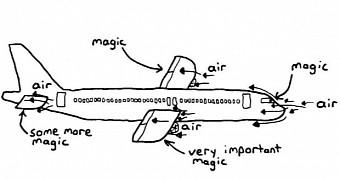Gravity can sometimes prove a serious pain in our behinds, this much has always been true to those who've had a close run-in with a flight of stairs or who aren't all that gifted at keeping their balance when walking on ice.
Still, planes have no trouble overcoming gravity and taking to the skies, even with us and our luggage nestled inside them. If you've ever wondered how they achieve this, just take about three minutes off your busy schedule to watch the video below.
As explained in this super cool animation, a plane's wings are designed to have air molecules bounce off their underbelly in greater numbers and with more force than off their upper side. This translates into pressure differences that push the plane up and keep it airborne.
Plane wings have no trouble getting air molecules to do their bidding because of how they are shaped - i.e. they are slightly curved - and because, during flight, they are fixed in an inclined position, the video details.
As for the engines, they serve to prevent the same air molecules that help a plane remain airborne from slowing it down by creating drag. Essentially, engines push air backwards and, in doing so, propel the plane forwards at a specific speed.

 14 DAY TRIAL //
14 DAY TRIAL // 